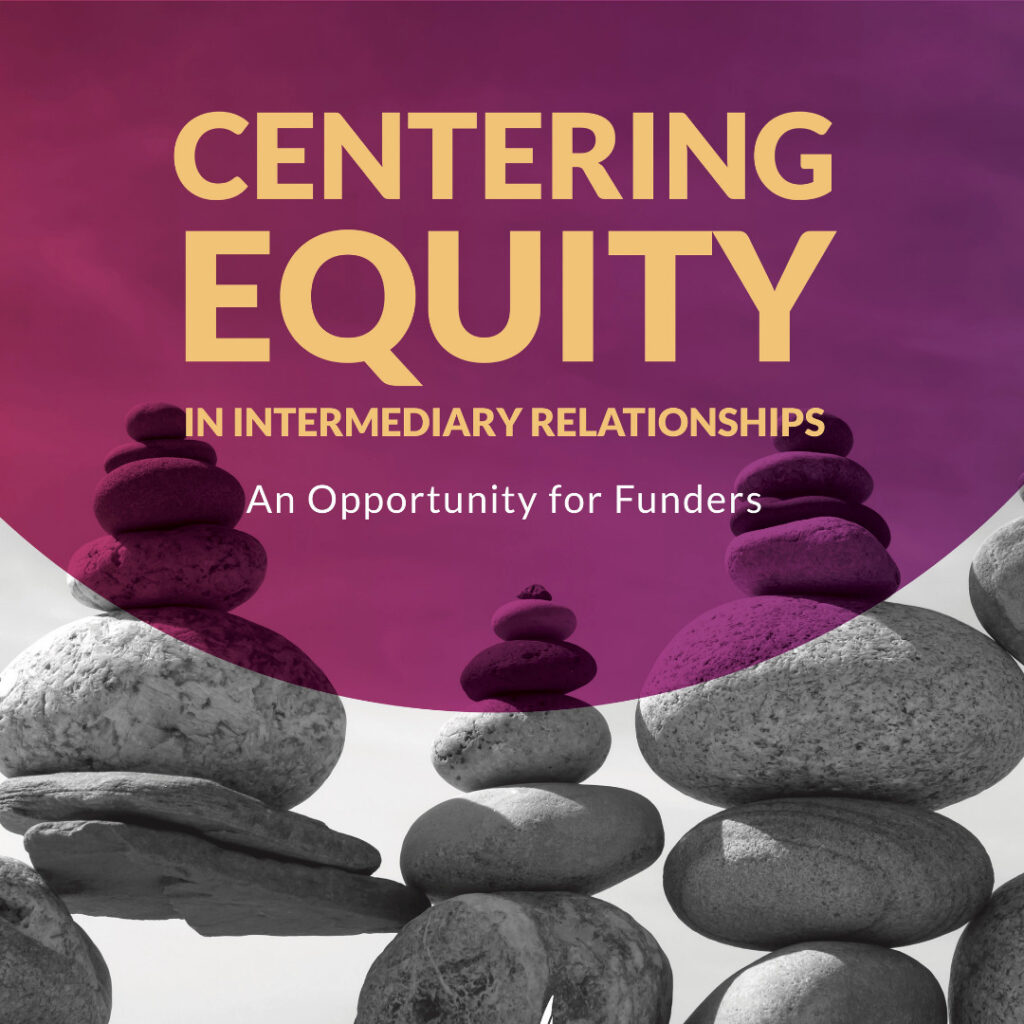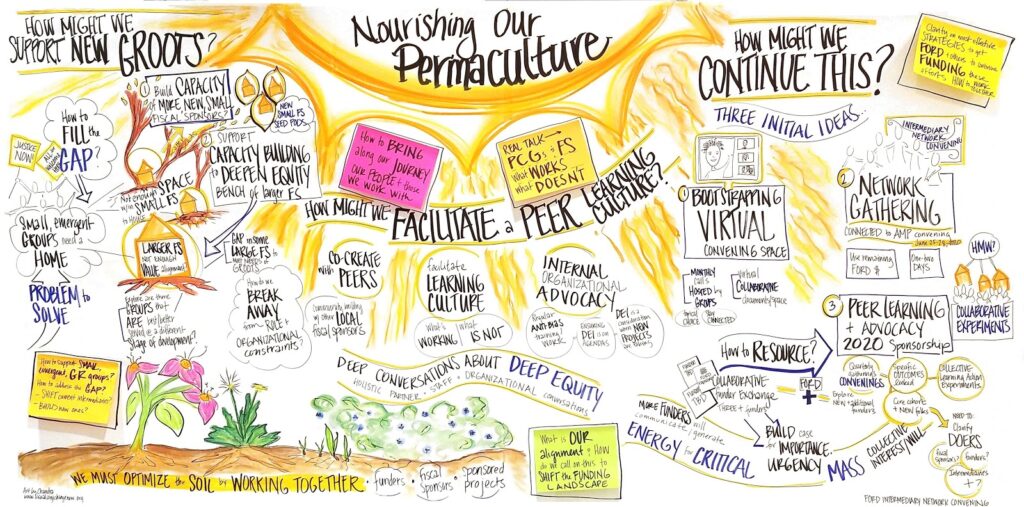Launched in 2019, and building off of previous research with grassroots groups and funder intermediaries, the Intermediary Design Lab was an 11-month cohort that brought together fiscal sponsors and donor intermediaries to reimagine their work in serving constituent-led groups—organizations, movement workers, and collectives that do not have formal 501c3 and/or 4 tax-exempt status and are often led by youth, people of color, members of the LGBTQI community, immigrants, and other historically oppressed groups. Intermediaries often support constituent-led groups to legally secure grant funding, develop strategy, and/or manage key back-office functions needed to do their work well. In providing these supports, intermediaries help create flexibility and extra capacity for emerging groups to refine and implement their strategy and test various organizational structures, with support from a more established organization.
The purpose of the Intermediary Design Lab was to surface the unique challenges that pertain to constituent-led groups, intermediaries, and funders and then start to advance change by launching a set of experiments aimed at addressing these issues. The challenges for each group varied:
- For funders, a primary need was for intermediaries to scale up the volume of funding and other supports to constituent-led groups and do so in alignment with equity.
- For a growing number of constituent-led groups, the primary need is in finding intermediaries that are equity-aligned and have the capacity to take on new sponsored projects and/or grantees.
- For intermediaries, the challenges related to scale didn’t have to do with volume, but rather about being more choiceful about the types of constituent groups they support to maximize their impact and create a portfolio greater than the sum of its parts. Their focus was also on deepening their equity capacity to better support the constituent-led groups they already serve and building stronger networks across intermediaries to address the growing need for their services.
The lab included three in-person convenings, experimentation across ten organizations (including intermediaries, Change Elemental, and the Ford Foundation), coaching, and other supports.
Experiments
Some examples of experiments conducted by lab participants include:
- Exploring alternative business models such as “anchor partnerships” to serve more constituent-led groups with smaller budgets: Most fiscal-sponsorship business models rely on larger sponsored projects subsidizing services to smaller projects—with groups paying a percentage to the sponsor and larger groups ultimately paying larger sums. For one fiscal sponsor, this common practice was in tension with their values of transparency and equity. They explored alternative ways of adding value and bringing in larger sponsored projects, including having a large “anchor” partner transparently underwrite support for smaller movement groups.
- Clarifying criteria for deciding which constituent-led groups to work with when capacity is limited: One intermediary created triage plans to better assess fit based on a prospective project’s mission alignment, the services they would need, their leadership, and their capacity to contribute to a particular need within the movement.
- Pursuing deeper equity in leadership and decision making: One intermediary experimented with building a network across sponsored projects. They used a model where sponsored projects were empowered to connect with each other without the fiscal sponsor acting as gatekeeper. They also piloted an advisory group made up of representatives from sponsored projects to create additional mechanisms for sponsored projects to provide input in decision-making.
- Evolving a large, highly complex intermediary to better serve constituent-led groups: Some intermediaries with the capacity to meet the size of giving that funders seek, and serve many grantees or sponsored projects groups at a time, may not always be structured to work effectively with constituent-led groups. Their service models are effective in serving a large number of groups but can fall short when it comes to serving groups that are smaller, more emergent, and demand services that center movement-building, power shifting, and equity as a core value. A few of these groups experimented with starting internal change processes with the capacity to shift systems and culture towards deeper equity.
Sharing the Lab’s Learning
Preliminary Research
Early research by Change Elemental on the needs of emerging social justice groups from their fiscal sponsors is shared in this infographic and blog.
Lab Report
The learnings from the lab’s ten experiments and previous research by Change Elemental, Frontlines Solutions, and Ingrid Benedict culminated in a report: Centering Equity in Intermediary Relationships: An Opportunity for Funders towards Values-Aligned Action.

Graphic Recording
Co-facilitator Chandra Larsen brought our discussions to life and integrated our learning with dynamic graphic facilitation.

Lab Participants
The following groups contributed their time, energy, and experiments over the course of 11 months in the lab.
- Allied Media Projects: Toni Moceri, A’leetzia Burns, and Sophia Softky
- Arabella Advisors/New Venture Fund: Lida Masoudpour and Aditi Naik
- Community Partners: Sheri Dunn Berry, Chikako Yamauchi, and Wendy Castillo
- Funders’ Collaborative on Youth Organizing: Eric Braxton and Kel Kroehle
- Movement Strategy Center: Sihle Dinani and Stephanie Wong
- Southern Vision Alliance: Elena Everett, Loan Tran, and Joe A. Lewis II
- Rainier Valley Corps: Ananda Valenzuela and JoJo Gaon
- Tides: Joel Bashevkin and Irini Neofotistos

Design and Facilitation Team
Toni, Sihle, Lida, and Eric also served on the design team and helped cocreate agendas for our three gatherings.
Natalie Bamdad at Change Elemental, Susan Misra at Aurora Commons, and Chandra Larsen led the research and analysis, design, and co-facilitation of the lab.
Other Partners and Contributors
This work was made possible by Marissa Tirona at Grantmakers Concerned with Immigrants and Refugees Grantmakers for Immigrants (formerly at the Ford Foundation) and Chris Cardona at the Ford Foundation, whose vision, thought partnership, and generosity were critical in moving this work forward, as well as Luna Yasui and program officers from other foundations who contributed their insights and advice.
Many intermediaries and constituent-led groups also contributed time and resources to supporting the development of the above report and helped us shape our understanding of the core challenges that the experiments might address.
What’s Next?
While the lab has ended, groups who participated continue to meet and learn together in partnership with fiscal sponsors who were not part of the lab in the Fiscal Sponsorship Network, which they initially launched as a Network Gathering at the 2020 Allied Media Conference.


